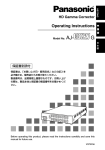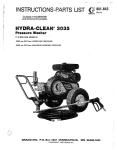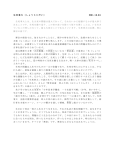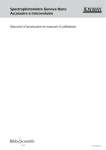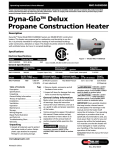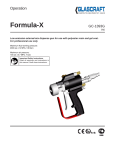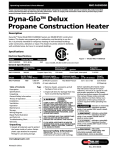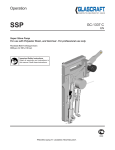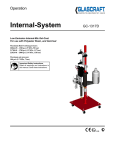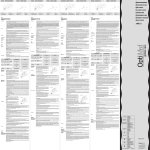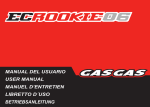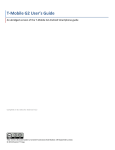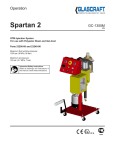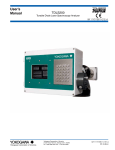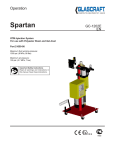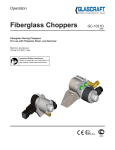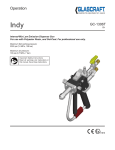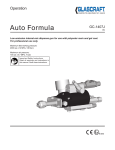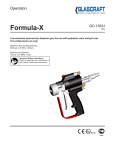Download GC-1395G G2, Operation, English
Transcript
Operation G2 Gel-Coat External Mix System For use with Polyester Resin and Gel-Coat Part 21990-00 Maximum fluid working pressure: 1300 psi. (9 MPa, 90 bar) Maximum air pressure: 100 psi. (0.7 MPa, 7 bar) Important Safety Instructions Read all warnings and instructions in this manual. Save these instructions. GC-1395G ENG Contents Warnings Warnings ............................................................................................................................................................ General Safety ................................................................................................................................................... Introduction ........................................................................................................................................................ 3 5 6 Set-up Set-up Instructions ............................................................................................................................................. Pressure Relief Instructions ............................................................................................................................... Start-up Instructions ........................................................................................................................................... Shut-down Instructions ....................................................................................................................................... Daily Start-up Instructions .................................................................................................................................. Parts ................................................................................................................................................................... Assembly Drawings ............................................................................................................................................ Sub-Assembly Drawings .................................................................................................................................... 7 9 10 13 14 15 16 19 Maintenance Maintenance ....................................................................................................................................................... Accesories .......................................................................................................................................................... 23 24 Technical Data Technical Data .................................................................................................................................................. Graco Ohio Standard Warranty ................................................................................................... Graco Ohio Information ............................................................................................................. 28 30 30 N/A = Non Applicable GC-1395G Warnings The following warnings are for the setup, use, grounding, maintenance, and repair of this equipment. The exclamation point symbol alerts you to a general warning and the hazard symbol refers to procedurespecific risk. Refer back to these warnings. Additional, product-specific warnings may be found throughout the body of this manual where applicable. • See Important Safety Information - MEKP, Polyester Resins and Gel-Coats and Spraying and Lamination Operations section of this manual. Changing Materials Changing Materials WARNING • When changing materials, flush the equipment multiple times to ensure it is thoroughly clean. FIRE AND EXPLOSION HAZARD • prevent and explosion: Always clean thefire fluid inlet strainers after flushing. Flammable fumes, such as solvent and paint fumes, in work area can ignite or explode. To help • • • • Use equipment only in well ventilated area. • Eliminate all ignition sources; for such as pilot lights, cigarettes, portable electric lamps, and plastic Check with your material manufacturer chemical drop cloths (potential static arc). compatibility. • Keep work area free of debris, including solvent, rags and gasoline. • Do not plug or unplug power cords, or turn power or light switches on or off when flammable Most materials useare ISO on the A side, but some use fumes present. ISO on the B side. • Ground all equipment in the work area. See Grounding instructions. • Use only grounded hoses. Epoxies•often have theofBgrounded (hardener) Hold gunamines firmly toon side pail when triggering into pail. • If there is static or you a shock, stop operation immediately. Do not use side. Polyureas often have sparking amines on the feel B (resin) equipment until you identify and correct the problem. side. • Keep a working fire extinguisher in the work area. PERSONAL PROTECTIVE EQUIPMENT You must wear appropriate protective equipment when operating, servicing, or when in the operating area of the equipment to help protect you from serious injury, including eye injury, This section inhalation is used with somefumes, RAM burns, plates and which couldloss. get pushed out of the drumsbut of is sealant. of toxic hearing This equipment includes not limited to: • Protective eyewear • Clothing and respirator as recommended by the fluid and solvent manufacturer • Gloves • Hearing protection Splatter Hazard WARNING TOXIC FLUID OR FUMES HAZARD SPLATTER Toxic fluids HAZARD or fumes can cause serious injury or death if splashed in the eyes or on skin, inhaled, or Hot or toxic fluid can cause serious injury if splashed in the eyes or on skin. During blow off of platen, swallowed. • Read MSDS’s splatter may occur.to know the specific hazards of the fluids you are using. Store hazardous in approved containers,platen and dispose of it according to applicable • • Use minimum airfluid pressure when removing from drum. • guidelines. Always wear impervious gloves when spraying or cleaning equipment. Burn Hazard For equipment used with heated material. GC-1395G WARNING BURN HAZARD - Hot Surfaces Equipment surfaces and fluid that’s heated can become very hot during operation. To avoid severe burns: • Do not touch hot fluid or equipment. Skin Injection Hazard Use with high pressure equipment, generally equipment with pressure rating of 900 psi or higher. There sions of this section. 1) manual guns, 2) UL-1450 compliant equipment 3) automatic guns,/dispense val Warnings tion valves, 4) heated hoses. Since the text contains mostly “Do not” statements, the symbols have lines them. WARNING WARNING SKIN HAZARD SKININJECTION INJECTION HAZARD - Basic High-pressure fluid from gun, hose leaks, or ruptured components will pierce skin. This may look High-pressure fluid from gun, hose leaks, or ruptured components will pierce skin. This may l like just a cut, but it is a serious injury that can result in amputation. Get immediate surgical a cut, but it is a serious injury that can result in amputation. Get immediate surgical treatm treatment. point gun at anyone at of any •• DoDo notnot point gun at anyone or at anyorpart thepart body.of the body. •• DoDo notnot put put youryour hand hand over the dispense outlet. tip. over the spray •• DoDo notnot stopstop or deflect leaks with yourwith hand, body, glove,body, or rag.glove, or rag. or deflect leaks your hand, •• Engage trigger lock when not Do not spray without tipspraying. guard and trigger guard installed. •• Follow Pressure Relief Procedure in spraying. this manual, when you stop spraying and before cleaning, Engage trigger lock when not checking, or servicing equipment. • Follow Pressure Relief Procedure in this manual, when you stop spraying and before c checking, or servicing equipment. MOVING PARTS HAZARD SKIN Use with UL1450 Compliance Moving INJECTION parts can pinchHAZARD or amputate- fingers and other body parts. not aim gun at,parts. or spray any person or animal. •DoKeep clearthe of moving •• DoKeep not operate equipment with protective covers hands and other body partsguards awayor from theremoved. discharge. For example, do not try to sto • Pressurized equipment can start without warning. Before checking, moving, or servicing any part of the body. equipment, follow the Pressure Relief Procedure in this manual. Disconnect power or air • supply. Always use the nozzle tip guard. Do not spray without nozzle tip guard in place. • Use Graco nozzle tips. •EQUIPMENT Use caution when cleaning and changing nozzle tips. in the case where the nozzle tip clo MISUSE HAZARD spraying, follow the Pressure Misuse can cause death or serious injury. Relief Procedure for turning off the unit and relieving the • Dobefore not operate the unitthe when fatigued the influence of drugs or alcohol. removing nozzle tiportounder clean. Fire and Explosion Hazard •• DoDo notnot exceed thethe maximum working pressure or temperature the lowest rated system leave unit energized or under pressure rating whileofunattended. When the unit is not component. See Technical Data in all equipment manuals. off the unit and follow the Pressure Relief Procedure for turning off the unit. • Use fluids and solvents that are compatible with equipment wetted parts. See Technical Data • in High-pressure sprayRead is able inject toxins into the body andFor cause serious bodily injury. all equipment manuals. fluidto and solvent manufacturer’s warnings. complete Pressurized Aluminum Parts Hazard that injection occurs, get request immediate information about your material, MSDS surgical forms from treatment. distributor or retailer. • Check hoses and parts for signs of damage. Replace any damaged hoses or parts. • Check equipment daily. Repair or replace worn or damaged parts immediately with genuine replacement parts only.parts only. Use with equipment pressurized aluminum Equipment havereplacement aluminum parts thatoraren’t pres • manufacturer’s Thiswith system is capable of producing XXXX psi. Usemay Graco parts accesso Dorated not alter or modify equipment. ized - check• with engineering. a minimum of XXXX psi. • Use equipment only for its intended purpose. Call your distributor for information. • Always engage the trigger lock when not spraying. Verify the trigger lock is functioning pr • Route hoses and cables away from traffic areas, sharp edges, moving parts, and hot surfaces. that all connections operating the unit. •• DoVerify not kink or over bend hoses or are use secure hoses to before pull equipment. • Know how to stop the unit and bleed pressure quickly. Be thoroughly familiar with the con • Keep children and animals away from work area. • WARNING Comply with all applicable safety regulations. PRESSURIZED ALUMINUM PARTS HAZARD PRESSURIZED ALUMINUM PARTS HAZARD Do not use 1,1,1-trichloroethane, methylene chloride, other halogenated hydrocarbon solvents or fluids Do not use methylene other containing such1,1,1-trichloroethane, solvents in pressurized aluminum equipment.chloride, Such use can causehalogenated serious chemical hydrocarbon solvents or fluid reaction and equipment rupture, and in death, serious injury, and property damage. containing such solvents in result pressurized aluminum equipment. Such use can cause serious chemical reaction and equipment rupture, and result in death, serious injury, and property damage. Plastic Parts Cleaning Solvent Hazard GC-1395G Created for CEDs Texture Sprayer. May have use with other waterbase application equipment with plastic parts th can be damaged by certain solvents. Important Safety Information Methyl Ethyl Ketone Peroxide (MEKP) MEKP is among the more hazardous materials found in commercial channels. Proper handling of the “unstable (reactive)” chemicals presents a definite challenge to the plastics industry. The highly reactive property which makes MEKP valuable to the plastics industry in producing the curing reaction of polyester resins and gel-coats also produces the hazards which require great care and caution in its storage, transportation, handling, processing and disposal. Workers must be thoroughly informed of the hazards that may result from improper handling of MEKP, especially in regards to contamination and heat. They must be thoroughly instructed regarding the proper action to be taken in the storage, use and disposal of MEKP and other hazardous materials used in the laminating operation. MEKP is flammable and potentially explosive, as well as potentially damaging to the eyes and skin. Read material manufacturer’s warnings and material MSDS to know specific hazards and precautions related to MEKP. Contaminated MEKP can become explosive. Prevent contamination of MEKP with other materials, which includes, but is not limited to polyester overspray, polymerization accelerators and promoters, and non-stainless metals. Even small amounts of contaminates can make MEKP explosive. This reaction may start slowly, and gradually build-up heat, which can accelerate until fire or an explosion result. This process can take from seconds to days. Heat applied to MEKP, or heat build-up from contamination reactions can cause it to reach what is called its Self-Accelerating Decompisition Temperature (SADT), which can cause fire or explosion. Spills should be promptly removed, so no residues remain. Spillage can heat up to the point of selfignition. Dispose in accordance with manufacture’s recommendation. Store MEKP in a cool, dry and well-ventilated area in the original containers away from direct sunlight and away from other chemicals. It is strongly recommended that the storage temperature remain below 86° F (30° C). Heat will increase the potential for explosive decomposition. Refer to NFPA 432. Keep MEKP away from heat, sparks and open flames. GC-1395G Current catalysts are premixed and do not require any diluents. GlasCraft strongly recommends that diluents not be used. Diluants add to the possibility of contaminates entering the catalyst system. Never dilute MEKP with acetone or any solvent since this can produce an extremely shock-sensitive compound which can explode. Use only original equipment or equivalent parts from GlasCraft in the catalyst system (i.e.: hoses, fittings, etc.) because a hazardous chemical reaction Spraying materials containing isocyanates creates may result between substituted parts and MEKP. potentially mists, vapors, and atomized To preventharmful contact with MEKP, appropriate personalparticulates. protective equipment, including chemically impermeable gloves, boots, aprons and goggles are required Read material manufacturer’s for everyone in the work area. warnings and material MSDS to know specific hazards and precautions related to isocyanates. Isocyanate Conditions • • • • Polyester Resins and Gel-Coats Prevent inhalation of isocyanate mists, vapors, and atomized particulates by providing sufficient ventilation in the work area. If sufficient ventilation is not available, a supplied-air respirator is required for Sprayinginmaterials containing everyone the work area. polyester resin and gel-coats creates potentially harmful mist, vapors and atomized particulates. Prevent inhalationappropriate by providing perTo prevent contact with isocyanates, sufficient ventilation and the use of respirators in the sonal protective equipment, including chemically work area. impermeable gloves, boots, aprons, and goggles, is Read the material manufacturer’s and maalso required for everyone in the warnings work area. terial MSDS to know specific hazards and precautions related to polyester resins and gel-coats. To prevent contact with polyester resins and gelcoats, appropriate personal protective equipment, including chemically impermeable gloves, boots, aprons and goggles are required for everyone in the work area. • • K B Material Self-ignition To we an Some materials may become self-igniting if applied too thickly. Read manufacturer’s warnings Spraying and material Lamination Operations and material MSDS. Fo B Moisture Sensitivity of Remove all accumulations of overspray, FRP sandIsocyanites ings, etc. from the building as they occur. If this waste is allowed to build are up, spillage of used catalyst more likely Isocyanites (ISO) catalysts in istwo component to start a fire. foam and polyurea coatings. ISO will react with moisture If cleaning solvents are required, read material (such as humidity) to form small, hard, abrasive crystals, manufacture’s warnings and material MSDS to know a film which become suspended in the fluid. Eventually specific hazards and precautions. (GlasCraft recomwill form on the surface and the ISO will begin to gel, mends that clean-up solvents be nonflammable.) increasing in viscosity. If used, this partially cured ISO will reduce performance and the life of all wetted parts. GlasCraft recommends that you consult OSHA The amount of film formation and rate of crystalliSections 1910.94, 1910.106, 1910.107 and NFPA zation varies depending on the blend of ISO, the No. 33, Chapter 16,17, and NFPA No. 91 for further humidity, and the temperature. guidance. To prevent exposing ISO to moisture: Som abo if ag circ Some materials may become self-igniting if applied Grounding too thickly. Read material manufacturer’s warnings and material MSDS. Moisture Sensitivity of Isocyanites This equipment needs to be grounded. Isocyanites (ISO) are catalysts used in two component Ground dispense gun through to anmoisture foam andthe polyurea coatings. ISOconnection will react with GlasCraft approved grounded fluid supply hose. (such as humidity) to form small, hard, abrasive crystals, which become suspended in the fluid. Eventually a film Check localsurface electrical code related manuals will formyour on the and theand ISO will begin to gel, for detailed grounding instructions of all equipment in ISO increasing in viscosity. If used, this partially cured the work area. will reduce performance and the life of all wetted parts. NOTICE To prevent cross-contamination of the equipment’s wetted parts, never interchange component A (isocyanate) and component B (resin) parts. Foam Resins with 245 fa Blowing Agents Some foam blowing agents will froth at temperatures above 90°F (33°C) when not under pressure, especially if agitated. To reduce frothing, minimize preheating in a circulation system. The amount of film formation and rate of crystallization varies depending on the blend of ISO, the A grounding wire and clamp are provided, humidity, and the temperature. assembly p/n 17440-00 with all FRP equipment. To prevent exposing ISO to moisture: Rev. G 6/17/2008 21 GC-1395G Moisture Sensitivity of Isocyanites Set-Up 1. Remove the pump inlet safety cap and drain the testing oil into an open container. Before operating the material pump, flush thoroughly with a clean suitable solvent to remove test fluid. 3. Isocyanites (ISO) are catalysts used in two component foam and polyurea coatings. ISO will react with moisture (such as humidity) to form hard, inlet abrasive 2. Attach clear pick-up hosesmall, to the pump fitting crystals, and which become suspended in the fluid. Eventually a film tighten. will form on the surface and the ISO will begin to gel, increasing in viscosity. If used, this partially cured ISO 3. Attach pick-up hose to the the pick-up tube. will reduceclear performance and life of all wetted parts. The amount of film formation and rate of crystallization varies depending on the blend of ISO, the humidity, and the temperature. GlasCraft uses a test fluid that may not be compatible with some gel-coats resins. Thus it is recommended To prevent exposingorISO to moisture: that the test fluid be flushed from the Material Pump Fluid Section. Rev. G 6/17/2008 Pick-up Tube 2. GC-1395G S a if c also required for everyone in the work area. Material Self-ignition Set-Up 4. Select a clean, dry air supply. Some materials become if on applied 5. Attach a 3/8” ormay larger air hoseself-igniting to the Air Inlet the Keep Components A and B Separate available, a supplied-air respirator is required for everyone in the work area. To prevent contact with isocyanates, appropriate personal protective equipment, including chemically NOTICE impermeable gloves, boots, aprons, and goggles, is preventfor cross-contamination of the equipment’s alsoTo required everyone in the work area. wetted parts, never interchange component A (isocyanate) and component B (resin) parts. Whenever flammable or combustible liquids are transfered Material Self-ignition Foam Resins with 245 fa Blowing Agents • K B from one container to another, both containers shall be effectively bonded and grounded to dissipate static electricity. For further information see..... NFPA 77, Recommended Practice on Static Electricity. Fire and Explosion Hazard Some foam blowing agents will froth at temperatures Some materials may self-igniting if applied 90°F (33°C) when not under pressure, especially 8. Fillabove material pump lubebecome cup with proper pump lube. tooifthickly. Read materialfrothing, manufacturer’s agitated. To reduce minimizewarnings preheating in a and material MSDS. circulation system. Use with high equipment with pressure rating of 900 psi or higher. There are 2 ve Isocyanites (ISO) arepressure catalystsequipment, used in twogenerally component sions of this section. 1) manual guns, 2) UL-1450 compliant equipment 3) automatic guns,/dispense valves,/lubri foam and polyurea coatings. ISO will react with moisture tion valves, 4) heated hoses. Since the text contains mostly “Do not” statements, the symbols have lines through (such as humidity) to form small, hard,equipment, abrasive crystals, Use with high pressure generally equipment with pressure rating of 900 psi or higher. There them. suspended in the fluid. Eventually a film which become sions of this section. 1) manual guns, 2) UL-1450 compliant equipment 3) automatic guns,/dispense valS a will form on the surface and the ISO will begin to gel, tion valves, 4) heated hoses. Since the text contains mostly “Do not” statements, the symbols have lines i increasing in viscosity. If used, this partially cured ISO them. reduce performance c will and the life of all wetted parts. Isocyanites (ISO) are catalysts used in two component The amount of film formation and rate of crystalli- foam and polyurea coatings. ISO will react with moisture zation varies depending on the blend of ISO, the (such as humidity) to form small, hard, abrasive crystals, which become suspended in the fluid. Eventually a film humidity, and the temperature. It is suggested that a quick disconnect fitting not be used for will form on the surface and the ISO will begin to gel, To prevent ISO to moisture: INJECTION HAZARD Basic attaching air.exposing QuickSKIN disconnect fittings can severely- limit air increasing in viscosity. If used, this partially cured ISO flow. willorreduce performance life of all wetted parts. High-pressure fluid from gun, hose leaks, ruptured componentsand willthe pierce skin. This may look like j tooyellow thickly. material airRead lock-out valve. manufacturer’s warnings and material MSDS. Fire and Explosion Hazard Moisture Sensitivity Skin Injection Hazard of Isocyanites Skin Injection Hazard Moisture Sensitivity of Isocyanites F B WARNING WARNING a cut, but it is INJECTION a serious injury that can result in amputation. Get immediate surgical treatment. SKIN HAZARD - Basic The amount of film formation and rate of crystalli• Do not point gun at anyone or at any partzation of the body. depending on the blend of ISO, the High-pressure fluid from gun, hose leaks, orvaries ruptured components will pierce skin. This may l • Do not put your hand over the spray tip. humidity, and the temperature. Rev. G 6/17/2008 21 a cut, but it is a serious injury that can result in amputation. Get immediate surgical treatm • Do not stop or deflect leaks with your hand, body, glove, or rag. GlasCraft recommends you contact your material supplier Before turning on main air, check all fittings, making certain • Do not point gun at anyone To or at any part of the body.to moisture: prevent exposing for their recommendation of a lubricant that will be suitable • Do not spray without tip before guard air and trigger guard installed.ISO they are securely tightened. should be done • ThisDo not put your hand over the spray tip. for use with your material. • Engage trigger lock when not spraying. or material of any kind is introduced into stop the system. • Do not or deflect leaks with your hand, body, glove, or rag. • Follow Pressure Relief Procedure in this manual, when you stop spraying and before cleaning, • Do not spray without tip guard and trigger guard installed. checking, or servicing equipment. Engage trigger lock to when not spraying. 6. Attach Grounding Clamp•Assembly, P/N 17440-00, Rev. G 6/17/2008 • Follow Pressure Relief Procedure this manual, when you stop spraying and before c System. Use a convenient Nut and Bolt to secure Lug, SKIN INJECTION HAZARD - Use with UL1450inCompliance P/N 13193-00, to slave pump.checking, or servicing equipment. Do not aim the gun at, or spray any person or animal. • Keep hands and other body parts away from the discharge. For example, do not try to stop leaks w any part of the body. grounded rod or pipe. Do not aim the gun at, or spray any person or animal. • Always use the nozzle tip guard. Do not spray without nozzle tip guard in place. • Keep hands and other body parts away from the discharge. For example, do not try to sto • Use Graco nozzle tips. any part of the body. • Use caution when cleaning and changing nozzle tips. in the case where the nozzle tip clogs while • Always use the nozzle tip guard. Do not spray without nozzle tip guard in place. spraying, follow the Pressure Relief Procedure for turning off the unit and relieving the pressure • Use Graco nozzle tips. Attach Here before removing the nozzle tip to clean. • Use caution when cleaning and changing nozzle tips. in the case where the nozzle tip cl • Do not leave the unit energized or under pressure while unattended. When the unit is not in use, tu spraying, follow the Pressure Relief Procedure for turning off the unit and relieving the off the unit and follow the Pressure Relief Procedure for turning off the unit. before removing the nozzle tip to clean. • High-pressure spray is able to inject toxins into the body and cause serious bodily injury. In the ev • Do not leave the unit energized or under pressure while unattended. When the unit is not that injection occurs, get immediate surgical treatment. off the unit and follow the Pressure Relief Procedure for turning off the unit. • Check hoses and parts for signs of damage. Replace any damaged hoses or parts. • High-pressure spray is able to inject toxins into the body and cause serious bodily injury. • This system is capable of producing XXXX psi. Use Graco replacement parts or accessories that a that injection occurs, get immediate surgical treatment. rated a minimum of XXXX psi. • Check hoses and parts for signs of damage. Replace any damaged hoses or parts. • Always engage the trigger lock when not spraying. Verify the trigger lock is functioning properly. • This system is TO capable of producing XXXX psi. Use Graco replacement parts or accesso SLAVE PUMP • Verify that all connections are secure before operating the unit. rated a minimum of XXXX psi. • Know how to stop the unit and bleed pressure quickly. Be thoroughly familiar with the controls. • Always engage the trigger lock when not spraying. Verify the trigger lockGC-1395G is functioning p • Verify that all connections are secure before operating the unit. • Know how to stop the unit and bleed pressure quickly. Be thoroughly familiar with the co SKIN INJECTION HAZARD - Use with UL1450 Compliance 7. Securely attach Clamp, P/N 7749-00 to permanently Pressure Relief Procedure To relieve fluid and air pressures: 1. Push down Yellow slide valve, P/N 21402-00 to bleed off air to system. 2. Open P/N 21228-00 on catalyst pump to recirculation position. 3. Open P/N 21192-00 on bottom of material pump. GC-1395G Start-Up 7. (Formula Gun Only) Adjust the trigger air regulator to 100 PSI (7 bar). 1. Pull and rotate Pivot knob to disengage the catalyst drive arm. The trigger air should not exceed 100 PSI (7 bar). 2. Turn the catalyst slave pump yellow ball valve to the open position. 3. Hand prime the pump until a steady stream of catalyst flows back to the bottle. 8. Remove Cap, Catalyst Ring, Spray Tip and Spacer from the gun. (refer to gun manual) 4. Close the ball valve. Hand stroke the pump until it developes 30-40 PSI (2-3 bar). 9. Trigger the Gun until a steady material stream appears at the Nozzle Body. The material regulator should initially be set not to exceed 10 PSI (0.7 bar). 5. Open the main air valve slowly. Changing Materials Changing Materials • When changing materials, flush the equipment multiple times to ensure it is thoroughly clean. • Always clean the fluid inlet strainers after flushing. • Check with your material manufacturer for chemical compatibility. • 10. Once a steady material stream is achieved, release trigger and re-assemble all parts removed from the gun. Most materials use ISO on the A side, but some use ISO on the B side. 6. Turn material• regulator slowly clockwise until guage Epoxies often have amines on the B (hardener) indicates 10 PSIside. (0.7Polyureas bar). The will cycle oftenpump have amines on theslowly B (resin) and stall when the pump is full of material. side. Cap, P/N LPA2-213, should be HAND TIGHTENED ONLY. Never use a wrench or pliers to assemble, tighten or remove this cap. If threads are clean and lubricated Splatter Hazard properly, assembly This section is used with some RAM plates which could get pushed out ofhand the drums of sealant.and removal will not be a problem. Use of wrenches or pliers will likely cause serve damage to the threads and/or Gun Head. WARNING SPLATTER HAZARD Hot or toxic fluid can cause serious injury if splashed in the eyes or on skin. During blow off of platen, splatter may occur. • Use minimum air pressure when removing platen from drum. Do not exceed 10 PSI (0.7 bar) pressure on the Material Regulator until steady material flow has been established. 10 Burn Hazard For equipment used with heated material. GC-1395G • Most materials ISO on the A side, butasome which become suspended in the use fluid. Eventually filmuse on the B side. will form on the surfaceISO and the ISO will begin to gel, increasing in viscosity. If used, this partially cured ISO • Epoxies often have amines on the B (hardener) will reduce performance the life allamines wetted side.and Polyureas oftenof have on theparts. B (resin) Start-Up side. The amount of film formation and rate of crystallization varies depending on the blend of ISO, the Follow step 12, if optional catalyst bottle is being used. humidity, and the temperature. 11. Slowly increase resin pressure regulator until desired spray pattern is achieved. (See Fig. 3) Hazard To prevent exposingSplatter ISO to moisture: This section is used with some RAM plates which could get pushed o Typical Spray Pattern Development 13. Safely fill the Catalyst Supply Bottle, P/N LPA-165 (maximum two gallons) with preferred MEKP catalyst to a minimum level at least one inch above the catalyst bottle outlet fitting. Rev. G 6/17/2008 (without Air Assist) WARNI STEP RESIN PATTERN PRESSURE PRESSURE ADJUSTMENT SPLATTER HAZARD Hot or toxic fluid can cause serious injury if splashed in the splatter may occur. • Use minimum air pressure when removing platen from ________________________________ 1 20 PSI INCREASE Remove Catalyst Bottle, P/N LPA-167-1, from Catalyst Bottle Bracket, P/N LPA-169, for filling. 2 25 PSI INCREASE 3 30 PSI INCREASE Bottle should beBurn placedHazard at or below waist-level for safe filling. For equipment used with heated material. 4 35 PSI* CORRECT Final pressure typically ranges from 30-45 PSI (2.1-3.1 bar) depending on material used. Fig. 3 Never fill Catalyst Bottle while mounted in Bracket as personal injury from catalyst spillage could result. WARNI HAZARDuntil - Hot all Surfaces 14. Trigger the Gun into BURN a container the air is Equipment and fluidItthat’s heated purged from the resin side ofsurfaces the system. may be can become ve • Do not hot fluidPump or equipment. necessary to Hand stroke thetouch Catalyst several Wait until equipment/fluid has cooled completely. times while the gun •is triggered to positively. 12. Slowly increase Air Assist Air Pressure Regulator until tails disappear from spray pattern. (See Fig. 4) Typical Spray Pattern Development (with Air Assist) STEP AIR ASSIST PATTERN PRESSURE ADJUSTMENT ADJUSTMENT 22 _________________________________ 1 CLOSED INCREASE 2 15 PSI INCREASE 3 30 PSI CORRECT Final air assist adjustment is complete when tails are elimated and a uniform spray pattern is achieved. Final pressure typically ranges from 30-45 PSI (2.1-3.1 bar) depending on material used. Fig. 4 GC-1395G 11 Moisture Sensitivity of Start-Up Isocyanites Material Self-ignition B Blowing Agents S Moisture Sensitivity of Some foam blowing agents will froth at temperatures a above 90°F (33°C) when not under pressure, especially i Isocyanites if agitated. To reduce frothing, minimize preheating in a should be determined by the type of resin release the Trigger and ISO stop will stroking andsetting material MSDS. foam and polyurea coatings. reactPump with Arm. moisture (such as humidity) to form small, hard, abrasive crystals, and catalyst being used. (such as humidity) to form small, hard, abrasive crystals, which become suspended in the fluid. Eventually a film which suspended in the a film will form on the surface and the ISO will begin to gel, 16.become Check and make certain thatfluid. SprayEventually Gun Material 20. Re-adjust catalyst atomizing air pressure to approxiwill formand onCatalyst the surface andactivate the ISO begin gel, Needles atwill exactly theto same increasing in viscosity. If used, this partially cured ISO mately PSI (2.8 bar). increasing time.in viscosity. If used, this partially cured ISO will reduce40performance and the life of all wetted parts. will reduce performance and the life of all wetted parts. amount of film and at rate crystalli The Failure to activate theformation Catalyst Valve theofGun The amount of film formation and rate of crystalli- Isocyanites zation varies depending on the blend of ISO, (ISO) areiscatalysts used inintwo when the Pump cycling will result an component over- the Catalyst Needle should never lead Material Needle as zation varies depending on the blend of ISO, the foam and humidity, and the temperature. polyurea coatings. ISO Pump will react pressurization of the Catalyst and with the moisture a loss of Catalyst system prime could result. humidity, and the temperature. (such as humidity) to form small, hard, abrasive crystals, automatic opening on the Pressure Relief Valve. To prevent exposing ISO to moisture: which become suspended in the fluid. Eventually a film To prevent exposing ISO to moisture: 17. Engage Catalyst drive arm to Material Pump. will the surface andexamine the ISOthe will begin to gel, 21. form Whileon triggering the Gun, atomized increasing viscosity. If used, this partially catalystin making certain it is properly enteringcured the ISO Knob will reduce and the life of all wetted parts. materialperformance pattern. Moisture Sensitivity of Isocyanites Rev. G 6/17/2008 Rev. The G 6/17/2008 amount of film formation and rate of crystalli- zation varies depending on the blend of ISO, the humidity, If catalyst pattern too narrow... and theistemperature. ... increase catalyst atomizing air in 5 PSI (0.3 bar) To prevent exposing ISO to moisture: increments. If catalyst pattern is too wide... ...decrease catalyst atomizing air in 5 PSI (0.3 bar) increments. Rev. G 6/17/2008 22. After all pressure adjustments have been complet- 18. Adjust catalyst atomizing air pressure to 25 PSI ed, a final spray test should be made. Spray a test shot sample on a clean piece of paper. This shot should be approximately five feet in length. You can now check for desired gel time and uniformity of curing. (1.7 bar). This pressure may be adjusted to achieve desired catalyst droplet size. 12 c Some materials may become self-igniting if applied Isocyanites (ISO) are catalysts used in two component circulation system. catalyst calibration as required. This 15. As soon as are all air is eliminated, tooRe-adjust thickly. Read material manufacturer’s Isocyanites (ISO) catalysts usedsimultaneously in two component 19. foam and polyurea coatings. ISO will reactwarnings with moisture GC-1395G F B S a if c 21 side. Splatter Hazard Shut-Down This section is used with some RAM plates which could get pushed o Shut-Down Instructions 1. WARNI Turn the main air valve to “Off” position. SPLATTER HAZARD Hot or toxic fluid can cause serious injury if splashed in the splatter may occur. • Use minimum air pressure when removing platen from Burn Hazard 6. Use a light coating of petroleum jelly on all threads For equipment used with heated material. and o-rings during re-assembly. WARNI 7. Material pump should be stopped with Pump Shaft in UP position. Shaft should be cleaned of any overspray or foreign material. 2. Turn catalyst yellow ball valve, P/N 21228-00 to Open / Recirculation position to dump psi. and close the valve. 8. BURN HAZARD - Hot Surfaces Equipment surfaces and fluid that’s heated can become ve Material Pump Lube •Cup Do should not touchbe hot emptied, fluid or equipment. cleaned and refilled withuntil clean, compatible lubricant. • Wait equipment/fluid has cooled completely. 9. Material pump should now be cycled so that shaft is left in DOWN positon during shut-down period. Failure to cycle Pump Shaft to DOWN position may result in over-spray or leaked material to dry or harden on Shaft. When Pump is next operated, severe damage may be done 22 to Upper Pump Seals. 3. Pressure should be maintained on the resin hose. 4. Refer to the manual to remove and clean the gun head parts. These parts should be cleaned thoroughly, inspected for wear or damage, O-Rings replaced if needed and placed aside for later re-as sembly at next start-up. 5. Clean and inspect all internal and external threads of the Gun Head. After cleaning, dry and lubricate all threads with a light coat of petroleum jelly. Make certain that the resin orifice on the inside of the Gun Head and the catalyst orifice on the outside of the Gun Head are covered with a small amount of the lubricant to prevent hardening and/or migration. GC-1395G 13 Daily Start-up 5. Engage Catalyst drive arm to Material Pump. 1. Pull and rotate Pivot knob to disengage the catalyst drive arm. Knob 2. Turn the catalyst slave pump yellow ball valve to the open position. 3. Hand prime the pump until a steady stream of catalyst flows back to the bottle. 4. Close the ball valve. Hand stroke the pump until it developes 30-50 PSI (2 TO 3 BAR). 14 6. Open the main air valve slowly. GC-1395G Parts Model - G2 System Part Number Description 21990-00 G2-SSP External mix gel-coat system 32513-00 Material pump assembly 13:1 ratio (Refer to material pump manual) SSP-160-02 Catalyst slave pump assembly (Refer to SSP manual) 20195-25 Material Hose Assembly 25 ft. 20190-00 Catalyst Hose Assembly 25 ft. 9704-53 AAC Tubing 30 ft. (Black) 9704-83 Atomizing Air Tubing 30 ft. (Red) GAM-268 Material pump pick-up kit 17440-00 Grounding clamp assembly GC-1395 User Manual GC-1395G 15 16 1/8” TUBING (Part 623-RC) SSP-190-02 SLAVE PUMP ASSEMBLY AIR MANIFOLD ASSEMBLY PUMP ASSEMBLY Assembly Drawings 21990-00 Assembly REVISION D GC-1395G Assembly Drawings 21990-00 Assembly REVISION D GC-1395G 17 Assembly Drawings 21990-00 Assembly Part Number Description CAT-105 CAP G-403 TARP STRAP GAM-268 PICK-UP TUBE ASSEMBLY SSP-157-02 CALIBRATION DECAL SSP-160-02 SLAVE PUMP MOUNTING BRACKET 13424-01 CABLE TIE 17440-00 GROUNDING CLAMP 18291-01 FLOOR BASE 19019-01 FLUID SECTION REPAIR KIT 19845-00 FRP LITERATURE KIT 19864-00 SUPPORT MAST 19882-00 SUPPORT MAST CAP 19890-01 MOUNTING CLAMP 20190-00 CATALYST HOSE 20195-25 MATERIAL HOSE 20368-00 SWIVEL CASTER 20572-00 FITTING 20573-00 BOTTLE LID 23555-03 AIR MANIFOLD 32513-00 13:1 PUMP ASSEMBLY 3923-02 SPIRAL WRAP 7486-04 WASHER 7733-42 HEX NUT 7734-10 LOCK WASHER 7957-32F SCREW 9704-03 TRIGGER AIR TUBING 9704-53 AAC TUBING 9704-83 ATOMIZING AIR TUBING REVISION C 18 GC-1395G Sub-Assembly Drawings 32513-00 Material Pump Assembly REVISION A GC-1395G 19 Sub-Assembly Drawings 32513-00 Material Pump Assembly Part Number Description AM-325 AIR MOTOR 1 P33-15-01 FLUID SECTION 1 P33-19 EXHAUST SILENCER 2 RM-850-02 TEE FITTING 1 SSP-142 SHAFT INSERT 1 SSP-143 SHAFT ADAPTER 1 SSP-149-01 LOCKING DETENT PIN 1 SSP-156 SLAVE PUMP STANDOFF 4 Qty. SSP-171 AIR MOTOR PLATE 1 11021-24 PIPE PLUG 1 14626-00 FITTING 1 19605-00 PUMP TAG 1 20260-00 BLEED HOSE 1 209 SURGE CHAMBER 21191-F 1 Part Number Description Qty. FLUID FILTER 1 909 100 MESH FILTER 1 21192-00 BALL VALVE 1 21044-04 O-RING 1 21465-44C 5/16” STUD 4 21189-00 RETAINER NUT 1 21219-00 HOUSING 1 22320-00 SLAVE PUMP PLATE 1 381 WASHER 8 4342-04 ELBOW FITTING 1 4342-23 ELBOW FITTING 1 558-01 GLASCRAFT NAMEPLATE 1 563 OSHA TAG 1 7597-04 SWIVEL FITTING 1 7729-07 HEX NUT 4 7734-07 LOCK WASHER 4 8156-40C SCREW 4 8462-12 FITTING 1 8462-15 FITTING 1 8462-17 FITTING 1 8560-03 CONNECTOR FITTING 1 9672-04 FITTING 1 9945-60C SCREW 4 REVISION A 20 GC-1395G Sub-Assembly Drawings 23555-03 Air Manifold Assembly Part Number Description Qty. Part Number Description Qty. ISD-141-3 MINI REGULATOR 2 21215-00 RELIEF VALVE 1 1625-03 PIPE PLUG 1 21402-00 3-WAY VALVE 1 CROSS FITTING 1 4342-04 ELBOW FITTING 1 4313-03 ISD-142 GUAGE 2 4342-02 ELBOW FITTING 1 LPA-143 FITTING 1 6782-03 TEE FITTING 1 18199-02 AIR REGULATOR 1 7597-04 SWIVEL FITTING 1 18318-02 AIR GUAGE 1 8115-03 FITTING 2 20182-00 MANIFOLD AAC DECAL 1 8115-06 FITTING 2 20183-00 ATOMIZE DECAL 1 20186-00 MAT’L DECAL 1 20655-02 ELBOW FITTING 1 GC-1395G REVISION D 21 Sub-Assembly Drawings GAM-268 Material Pick-Up Kit Assembly Part Number Description Qty. AP-146 HOSE 6 FT. GAM-248 PICK-UP TUBE 1 GAM-263 FILTER 1 3161 HOSE FITTING 2 4341-15 ELBOW FITTING 1 8560-11 FITTING 1 8612-08 BAND CLAMP 2 REVISION E 22 GC-1395G Moisture Sensitivity of Isocyanites Maintenance Blowing Agents Some foam blowing agents will froth at temperatures above 90°F (33°C) when not under pressure, especially if agitated. To reduce frothing, minimize preheating in a circulation system. Isocyanites (ISO) are catalysts used in two component 3. Clean pump lube cup and add fresh pump lube. foam and polyurea coatings. ISO will react with moisture (such as humidity) to form small, hard, abrasive crystals, which become suspended in the fluid. Eventually a film Before to perform maintenance onto this will formattempting on the surface and any the ISO will begin gel, System Relieve All Fluid and Air Pressures! increasing in viscosity. If used, this partially cured ISO See Previous page. will reduce performance and the life of all wetted parts. The amount of film formation and rate of crystallization varies depending on the blend of ISO, the humidity, and the temperature. See Indy and Formula gun manuals for daily maintenance To prevent exposing ISO to moisture: and parts replacement procedures. 1. Clean filter at resin pump. When opening pump relief valve,Gmake sure all resin and air is evacuated from surge Rev. 6/17/2008 21 bottle. Fluid Filter Assembly 2. Inspect and clean filter on pick-up wand. Filter GC-1395G 23 Accessories 21460-00 Heater Conversion Kit Assembly 24 GC-1395G Accessories 21460-00 Heater Conversion Kit Assembly Part Number Description D-156-04 RM-850-02 14626-00 HOSE, ASSY 1 FITTING, PIPE, TEE, 3/8 1 FITTING, 3/8NPT X 3/8 NPS 2 14626-01 FITTING, 3/8NPT X 1/4 NPSM 2 19891-00 CLAMP, PIPE, SET 2 19892-00 PLATE, COVER, CLAMP 2 20027-00 FITTING, ELBOW, 1/2NPTM X 1/2NPTF CP 1 HEATER, VISCON (240 VOLT) 1 21192-00 VALVE, BALL, 2-WAY, 3/8 1 GCC470 PLATE, HEATER, MOUNTING 1 226819 96/0017/99 NUT, HEX, 1/4-20, MS, GR2 4 4342-23 FITTING, ELBOW, 3/8 NPTM X 3/8 NPTF 1 7734-10 WASHER, LOCK, SPRING, 1/2 4 8155-160C GC-1395G Qty SCREW, HXHD, CS, .500-13X5.000ZP 4 8462-15 FITTING, PIPE, NIPPLE, HEX, 1/2 X 3/8 NPT 2 8462-17 FITTING, PIPE, NIPPLE, HEX, 3/8 X 3/8 NPT 1 96/0071/99 NUT, HEX, 1/2-13, MS, GR2 4 96/0037/99 WASHER, LOCK, SPLIT, 1/4, MS 4 96/0041/99 WASHER, FLAT, 1/4, 0.28 X 0.63 X 0.065 8 96/0058/99 SCREW, HHC, 1/4-20 X 1.50, MS, GR5 4 25 Accessories LPA-165 Catalyst Bottle Assembly Part Number Description Qty. LPA-167-1 BOTTLE 1 LPA-172 SCREEN 1 LPA-176 CAP 1 21039-00 TUBE ADAPTER 1 21040-00 ELBOW FITTING 1 21044-01 SEAL 1 21045-01 HEX NUT 1 9704-11 TUBING 5 REVISION N 26 GC-1395G Accessories LPA-170 Catalyst Bottle Bracket Assembly Part Number Description Qty. CP-126 U-BOLT 2 LPA-169 BOTTLE SUPPORT 1 7486-07 WASHER 4 7734-07 LOCK WASHER 4 REVISION B GC-1395G 27 Technical Data 28 Category Data Maximum Fluid Working Pressure 1300 psi (9 MPa, 90 bar) Maximum Air Inlet Pressure 100 psi (0.7 MPa, 7 bar) Typical Flow Rate of Pattern Guns Refer to gun manual Maximum Fluid Temperature 100° F (38° C) B Component (Resin) Inlet Size 1 5/16-12 UN-2A Male Sound Pressure 81.71 dB(A) Sound Power, measured per ISO 9614-2 82.82 dB(A) Dimensions 30 L X 30 W X 59 H ( 762 X 762 X 1498.6 mm) Weight 175 Lbs. (80 kg) Wetted Parts Catalyst- Chemically coated aluminum, stainless steel, chemically resistant o-rings Resin- Carbon steel, carbide, chemically resistant orings. GC-1395G Notes GC-1395G 29 Graco Ohio Standard Warranty Graco warrants all equipment referenced in this document which is manufactured by Graco and bearing its name to be free from defects in material and workmanship on the date of sale to the original purchaser for use. With the exception of any special, extended, or limited warranty published by Graco, Graco will, for a period of twelve months from the date of sale, repair or replace any part of the equipment determined by Graco to be defective. This warranty applies only when the equipment is installed, operated and maintained in accordance with Graco’s written recommendations. This warranty does not cover, and Graco shall not be liable for general wear and tear, or any malfunction, damage or wear caused by faulty installation, misapplication, abrasion, corrosion, inadequate or improper maintenance, negligence, accident, tampering, or substitution of non-Graco component parts. Nor shall Graco be liable for malfunction, damage or wear caused by the incompatibility of Graco equipment with structures, accessories, equipment or materials not supplied by Graco, or the improper design, manufacture, installation, operation or maintenance of structures, accessories, equipment or materials not supplied by Graco. This warranty is conditioned upon the prepaid return of the equipment claimed to be defective to an authorized Graco distributor for verification of the claimed defect. If the claimed defect is verified, Graco will repair or replace free of charge any defective parts. The equipment will be returned to the original purchaser transportation prepaid. If inspection of the equipment does not disclose any defect in material or workmanship, repairs will be made at a reasonable charge, which charges may include the costs of parts, labor, and transportation. THIS WARRANTY IS EXCLUSIVE, AND IS IN LIEU OF ANY OTHER WARRANTIES, EXPRESS OR IMPLIED, INCLUDING BUT NOT LIMITED TO WARRANTY OF MERCHANTABILITY OR WARRANTY OF FITNESS FOR A PARTICULAR PURPOSE. Graco’s sole obligation and buyer’s sole remedy for any breach of warranty shall be as set forth above. The buyer agrees that no other remedy (including, but not limited to, incidental or consequential damages for lost profits, lost sales, injury to person or property, or any other incidental or consequential loss) shall be available. Any action for breach of warranty must be brought within two (2) years of the date of sale. GRACO MAKES NO WARRANTY, AND DISCLAIMS ALL IMPLIED WARRANTIES OF MERCHANTABILITY AND FITNESS FOR A PARTICULAR PURPOSE, IN CONNECTION WITH ACCESSORIES, EQUIPMENT, MATERIALS OR COMPONENTS SOLD BUT NOT MANUFACTURED BY GRACO. These items sold, but not manufactured by Graco (such as electric motors, switches, hose, etc.), are subject to the warranty, if any, of their manufacturer. Graco will provide purchaser with reasonable assistance in making any claim for breach of these warranties. In no event will Graco be liable for indirect, incidental, special or consequential damages resulting from Graco supplying equipment hereunder, or the furnishing, performance, or use of any products or other goods sold hereto, whether due to a breach of contract, breach of warranty, the negligence of Graco, or otherwise. FOR GRACO CANADA CUSTOMERS The Parties acknowledge that they have required that the present document, as well as all documents, notices and legal proceedings entered into, given or instituted pursuant hereto or relating directly or indirectly hereto, be drawn up in English. Les parties reconnaissent avoir convenu que la rédaction du présente document sera en Anglais, ainsi que tous documents, avis et procédures judiciaires exécutés, donnés ou intentés, à la suite de ou en rapport, directement ou indirectement, avec les procédures concernées. Graco Ohio Information For the latest information about Graco products, visit www.graco.com. TO PLACE AN ORDER, contact your Graco distributor or call to identify the nearest distributor. Phone: 1-800-746-1334 or Fax: 1-330-966-3006 All written and visual data contained in this document reflects the latest product information available at the time of publication. Graco reserves the right to make changes at any time without notice. Original instructions. This manual contains English. GC-1395 Graco Headquarters: Minneapolis International Offices: Belgium, China, Japan, Korea GRACO OHIO INC. 8400 PORT JACKSON AVE NW, NORTH CANTON, OH 44720 Copyright 2008, Graco Ohio Inc. is registered to ISO 9001 www.graco.com Revised 08/2010































